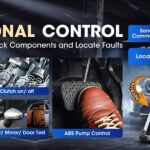A reliable diagnostic tool is essential for any car owner looking to understand and resolve vehicle issues. This article explores options for finding a reasonably priced OBD2 scanner capable of reading and resetting ABS and SRS (Supplemental Restraint System) codes, focusing on tools that offer comprehensive functionality beyond basic engine code reading.
Why a Specialized Diagnostic Tool is Necessary
Intermittent warning lights for ABS (Anti-lock Braking System) and TCS (Traction Control System) often indicate underlying problems that require accurate diagnosis. A basic OBD2 scanner that only reads engine codes won’t suffice. Accessing and interpreting ABS and SRS codes demands a more specialized tool capable of communicating with these specific vehicle systems. These advanced diagnostic tools can pinpoint issues like faulty wheel speed sensors, enabling targeted repairs and preventing potentially dangerous braking malfunctions.
Exploring Diagnostic Tool Options
While some vehicle manufacturers offer proprietary diagnostic software and tools, their cost can be prohibitive for the average car owner. Thankfully, the aftermarket provides a range of options with varying capabilities and price points.
One popular choice is the Autel MaxiLink ML629. This tool provides comprehensive diagnostic functionality, including reading and clearing ABS and SRS codes, for a wide range of vehicle makes and models.
Another option is the Foxwell NT530. This versatile scanner supports multiple car brands and offers in-depth diagnostic capabilities, including ABS and SRS system access. It requires downloading specific manufacturer software, providing a tailored diagnostic experience.
For budget-conscious users, ForScan offers a compelling alternative. This software, combined with a modified ELM327 adapter, can access a surprising depth of diagnostic information on various Ford, Mazda, and Lincoln vehicles. It’s important to note that using ForScan requires some technical knowledge and a compatible adapter.
Other reputable brands like Snap-On offer high-quality diagnostic tools with modular functionality. Purchasing a base scanner and then adding manufacturer-specific keys allows users to customize the tool to their needs. This can be a cost-effective solution for those working on multiple vehicle brands.
Considerations When Choosing a Tool
Several factors influence the choice of an ABS, SRS, and OBD2 diagnostic tool:
- Vehicle Compatibility: Ensure the tool supports the specific make and model of your vehicle. Some tools offer broader coverage than others.
- Functionality: Determine the required diagnostic capabilities beyond ABS and SRS codes. Some tools offer features like live data streaming, bi-directional control, and special functions.
- Update Frequency: Regular software updates are crucial for maintaining compatibility with newer vehicle models and addressing potential bugs.
- Price: Balance functionality and features with budget constraints. While professional-grade tools can be expensive, affordable options still offer comprehensive capabilities for DIY enthusiasts.
- User Experience: Consider factors like ease of use, screen size, and menu navigation.
Conclusion
Investing in an ABS, SRS, and OBD2 diagnostic tool empowers car owners to troubleshoot and resolve issues effectively. While professional mechanics rely on high-end equipment, a range of affordable options cater to the needs of DIY enthusiasts. By carefully considering vehicle compatibility, required functionality, and budget, car owners can select the ideal tool for their diagnostic needs, ensuring safe and reliable vehicle operation.

